When I arrived in Seattle it was still fairly early in the morning and most places were closed. However, the overpowering smell of fresh bread drew me magnetically towards the Grand Bakery in Occidental Square. That was breakfast sorted, a fruity scone and a mug of coffee. When I left the bakery to walk down to the sea front I came across other newly baked bread aromas, but resisted the temptation.
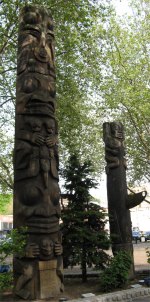 Totem Poles in Occidental Square |
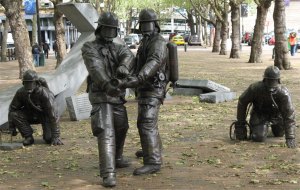 Seattle Fallen Firefighters Memorial |
I headed up to Pike Place Market, established in 1907, the country's oldest continuously operating farmers market, said to be the soul of Seattle, to find hosts of freshly cut flowers, fruit and vegetables of abnormal sizes, shell fish and fish, the latter being passed about by fishmongers by throwing. This was a noisy, bustling and colourful market with a personality of its own, and it was easy to see how it has become a popular tourist attraction. Sadly I couldn't dawdle there since I had booked up a city tour and time was pressing.
The tour guide was Mark, and when he heard who I was he went into raptures and told the rest of the bus about David Douglas, the botanist who had traveled across here to name a fir after him. It would take too many pages to cover all the things Mark talked about or showed us on the trip. His tour took us along the sea front, pointing out the many fine seafood restaurants, ferry terminals and piers. One amusing story he related to us was about the Edgewater Hotel, which was built over the water. The hotel was built in 1962 with the aim of being ready for a World Fair being held in Seattle. Sadly it wasn't completed until five days are the event had ended. The owners were peeved, but still wanted to open the hotel with flair, and came up with the gimmick of providing customers with rods and lines so that they could fish out of their windows. This facility was offered for many years. Apparently there is a famous photograph of the Beatles fishing out of the windows.
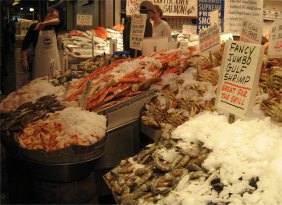 Fish in Pike Place Market |
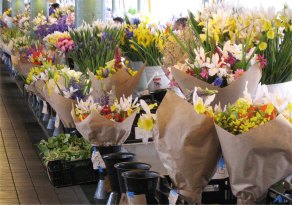 Flowers in Pike Place Market |
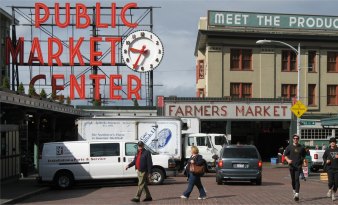 Pike Street Entrance to Pike Place Market |
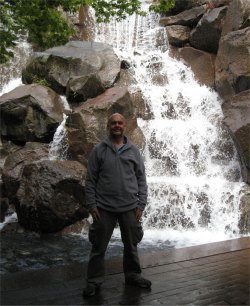 Waterfall Garden |
 Underpass Troll |
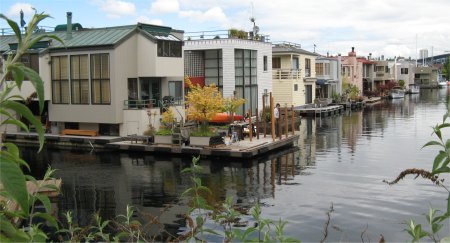 Floating Houses on Union Lake |
A short journey from there through the lush suburbs of Queen Anne Hill brought us to the locks that separate the freshwater Union Lake and Lake Washington from the sea, 20' below them. Adjacent to the locks is a dam to hold back the waters, where provision is made to allow smolt (young salmon) to safely travel from the freshwater environment to the lower saltwater sea section of the canal leading to the sea. Salmon 'stairs' are also provided to allow the salmon to return back up to the freshwater levels when they return to spawn. Well thought out.
The final stage of the trip was over Magnolia, an extremely beautiful area with immaculate, landscaped gardens full of every tree and shrub conceivable. Flowers were in abundance, especially rhododendrons, the Washington State flower. The views from the tops across to the Sound were stupendous. We swept back down to downtown Seattle, passing a couple of cruise ships readying themselves for another tour up along the Alaskan coastline.
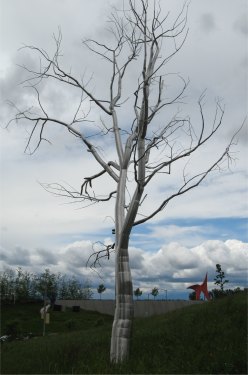 Stainless Steel Tree in the Sculpture Park |
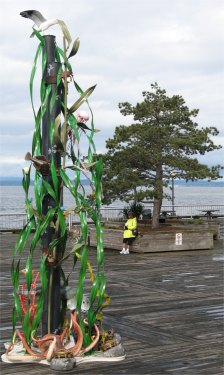 Sea Front Sculpture |
 Space Needle |
Shortly after leaving the tower, I opened a door for an elderly lady and after the brief exchange of pleasantries she asked, "Are you Irish?" I explained I was from the north of England and my dialect could be confused with Irish, "To do with the Viking invasion of northern England and their impact upon the northern dialect", I said. "Oh, I'm sorry", she grinned. I responded by saying, "Don't worry about it, my mother-in-law was Irish, and she never understood a word I said". "Well I did", she retorted. We both burst into laughter.
I knew that while in Seattle I ought to try the fish, and after seeking local advice, headed to McCormick's Fish House Bar. The McCormick's chain has Irish roots, and serves Guinness brewed in Pittsburgh. I was treated to an absolutely delicious meal of Canadian Silverhead on a bed of purple potatoes, onions and blackberries. Out of this world! As I sat at the bar enjoying my food, I got chatting with the chap next to me. He also knew the bartender well, so it turned into a three way conversation. I got the full run down on the types of fish to be found in the vicinity, and where they could be caught. I thus thought he must be local but he was from Cincinnati, and his work had brought him here; he was an airline pilot killing time till his 11pm flight home. The conversation focus shifted to my reason for being here. I outlined my trip which he enthused over and would love to take on board himself. He had done short treks with his family, and when he spotted on my itinerary that I would be crossing from Wyoming to Colorado near Rock Springs in a month's time, he bubbled forth with some time he had spent there with his family. Apparently the Green River runs through Flaming Gorge, and a small outfit there can kit you out with fishing gear and a boat for trout fishing, the boat allowing to gently drift along the emerald green waters. He passed on to me the details, and we parted company with him wishing me good luck.
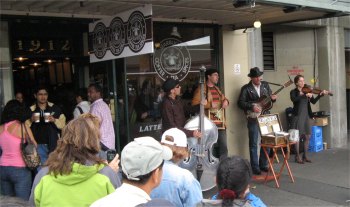 The Original Starbucks |
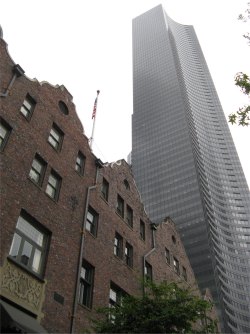 Contrasting Architectures |
I had time to take in one small art gallery before heading back for my train. There are plenty of small galleries to choose from in Seattle.
As the train wound its way back up the coast, I had time to reflect on my first impression of Seattle. It is a thriving city, full of vitality, though the folk aren't laughing and joking as much as the San Franciscans. The folk from Seattle seemed to be a well worn breed with wise heads on their shoulders, and were always polite and helpful. There were nowhere near as many "homeless people" here than in San Francisco. This could be due to the fact that there are several hostels for the homeless in the city centre. Another thing that struck me about the city was its dedication to medicine. There are numerous cancer and kidney clinics, and many medical research centres.
On reflection, a lovely day to get rid of the van blues.

